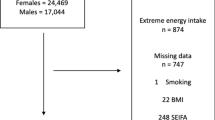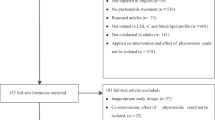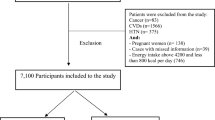Abstract
Background/ Objectives:
We evaluated plant sterol and stanol (PS) intakes from natural sources and enriched foods in the Finnish population-based national FINDIET 2007 Survey. In addition, we compared the users and nonusers of PS-enriched foods in terms of their characteristics and dietary intake.
Subjects/Methods:
This was a cross-sectional population-based study on 958 men and 1080 women aged 25–74. Users and nonusers of PS-enriched products were compared with respect to sex, age, education, region, cholesterol-lowering medication and cholesterol-lowering diet. Intakes of PS, energy, energy nutrients, fat composition, cholesterol and dietary fibre were calculated on the basis of a 48-h dietary recall. The distribution of PS intake was assessed for the users of enriched products.
Results:
PS-enriched foods were used by 9.5% of all subjects. The usage increased significantly with age (P<0.001) and level of education (P=0.01). The usage of enriched products was more common among those following a cholesterol-lowering medication or diet (P<0.001 for both). Among users, the mean intake of PS was 2.2 g/d for men and 1.6 g/d for women, and among nonusers it was 363 mg/d for men and 286 mg/d for women. The majority of users received less than 2 g/d of PS from enrichment, but 20% of users obtained more than 3 g of PS per day.
Conclusions:
The intake of PS can reach several grams in a subgroup of subjects consuming PS-enriched foods. The manufacturers’ recommendations on PS-enriched food consumption are not consistently followed, and customer guidance needs to be improved.
This is a preview of subscription content, access via your institution
Access options
Subscribe to this journal
Receive 12 print issues and online access
$259.00 per year
only $21.58 per issue
Buy this article
- Purchase on Springer Link
- Instant access to full article PDF
Prices may be subject to local taxes which are calculated during checkout
Similar content being viewed by others
References
Piironen V, Toivo J, Puupponen-Pimiä R, Lampi A-M . Plant sterols in vegetables, fruits and berries. J Sci Food Agr 2003; 83: 330–337.
Valsta LM, Lemström A, Ovaskainen M-L, Lampi A-M, Toivo J, Korhonen T et al. Estimation of plant sterol and cholesterol intake in Finland: quality of new values and their effect on intake. Br J Nutr 2004; 92: 671–678.
EFSA Panel on Dietetic Products, Nutrition and Allergies (NDA). Scientific Opinion on the substantiation of a health claim related to 3 g/day plant sterols/stanols and lowering blood LDL-cholesterol and reduced risk of (coronary) heart disease pursuant to Article 19 of Regulation (EC) No 1924/20061. EFSA J 2012; 10: 2693.
Gylling H, Hallikainen M, Nissinen MJ, Simonen P, Miettinen TA . Very high plant stanol intake and serum plant stanols and non-cholesterol sterols. Eur J Nutr 2010; 49: 111–117.
Mensink RP, de Jong A, Lütjohann D, Haenen GR, Plat J . Plant stanols dose-dependently decrease LDL-cholesterol concentrations, but not cholesterol-standardized fat-soluble antioxidant concentrations, at intakes up to 9 g/d. Am J Clin Nutr 2010; 92: 24–33.
EFSA. Consumption of food and beverages with added plant sterols. EFSA J 2008; 133: 1–21.
Hearty A, Duffy E, Joyce J, O’Connor C, Gibney MJ . Phytosterol-enriched products on the Irish market: examination of intake and consumption patterns. Public Health Nutr 2009; 12: 51–58.
Sioen I, Matthys C, Huybrechts I, Van Camp J, De Henauw S . Consumption of plant sterols in Belgium: consumption patterns of plant sterol-enriched foods in Flanders, Belgium. Br J Nutr 2011; 105: 911–918.
Kuhlmann K, Lindtner O, Bauch A, Ritter G, Woerner B, Niemann B . Simulation of prospective phytosterol intake in Germany by novel functional foods. Br J Nutr 2005; 93: 377–385.
De Jong N, Pijpers L, Bleeker JK, Ocké MC . Potential intake of phytosterols/-stanols: results of a simulation study. Eur J Clin Nutr 2004; 58: 907–919.
Valsta LM, Tapanainen H, Sundvall J, Laatikainen T, Männistö S, Pietinen P et al. Explaining the 25-year decline of serum cholesterol by dietary changes and use of lipid-lowering medication in Finland. Public Health Nutr 2010; 13: 932–938.
Reinivuo H, Hirvonen T, Ovaskainen ML, Korhonen T, Valsta LM . Dietary survey methodology of FINDIET 2007 with a risk assessment perspective. Public Health Nutr 2010; 13: 915–919.
Simojoki M, Luoto R, Uutela A, Rita H, Boice JD Jr, McLaughlin JK et al. Use of plant stanol ester margarine among persons with and without cardiovascular disease: early phases of the adoption of a functional food in Finland. Nutr J 2005; 4: 20.
De Jong N, Simojoki M, Laatikainen T, Tapanainen H, Valsta L, Lahti-Koski M et al. The combined use of cholesterol-lowering drugs and cholesterol-lowering bread spreads: health behavior data from Finland. Prev Med 2004; 39: 849–855.
Boylan S, Lallukka T, Lahelma E, Pikhart H, Malyutina S, Pajak A et al. Socio-economic circumstances and food habits in Eastern, Central and Western European populations. Public Health Nutr 2011; 14: 678–687.
Konttinen H, Sarlio-Lähteenkorva S, Silventoinen K, Männistö S, Haukkala A . Socio-economic disparities in the consumption of vegetables, fruit and energy-dense foods: the role of motive priorities. Public Health Nutr 2013; 16: 873–882.
Musa-Veloso K, Poon TH, Elliot JA, Chung C . A comparison of the LDL-cholesterol lowering efficacy of plant stanols and plant sterols over a continous dose range: results of a meta-analysis of randomized placebo-controlled trials. Prostagl Leukotr Essent Fatty Acids 2011; 85: 9–28.
Normén AL, Brants HA, Voorrips LE, Andersson HA, van den Brandt PA, Goldbohm RA . Plant sterol intakes and colorectal cancer risk in the Netherlands Cohort Study on Diet and Cancer. Am J Clin Nutr 2001; 74: 141–148.
Andersson SW, Skinner J, Ellegård L, Welch AA, Bingham S, Mulligan A et al. Intake of dietary plant sterols is inversely related to serum cholesterol concentration in men and women in the EPIC Norfolk population: a cross-sectional study. Eur J Clin Nutr 2004; 58: 1378–1385.
Chen Q, Gruber H, Swist E, Coville K, Pakenham C, Ratnayake WM et al. Dietary phytosterols and phytostanols decrease cholesterol levels but increase blood pressure in WKY inbred rats in the absence of salt-loading. Nutr Metab (Lond) 2010; 7: 11.
Goncalves A, Gleize B, Bott R, Nowicki M, Amiot MJ, Lairon D et al. Phytosterols can impair vitamin D intestinal absorption in vitro and in mice. Mol Nutr Food Res 2011; 55: S303–S311.
Marttinen M, Päivärinta E, Storvik M, Huikko L, Luoma-Halkola H, Piironen V et al. Plant stanols induce intestinal tumor formation by up-regulating Wnt and EGFR signaling in Apc(Min) mice. J Nutr Biochem 2013; 24: 343–352.
De Jong A, Plat J, Mensink RP . Metabolic effects of plant sterols and stanols (Review). J Nutr Biochem 2003; 14: 362–369.
Klingberg S, Winkvist A, Hallmans G, Johansson I . Evaluation of plant sterol intake estimated with the Northern Sweden FFQ. Public Health Nutr 2012; 16: 460–467.
Luoto R, Simojoki M, Uutela A, Boice JD Jr, McLaughlin JK, Puska P . Consistency of use of plant stanol ester margarine in Finland. Public Health Nutr 2004; 7: 63–68.
Acknowledgements
We thank Heli Tapanainen for her assistance in the statistical analyses. This study was funded by the Finnish Food Research Foundation and the Jenny and Antti Wihuri Foundation. The National Institute for Health and Welfare (former National Public Health Institute) in Finland is acknowledged for making the national FINDIET 2007 Survey possible.
Author information
Authors and Affiliations
Corresponding author
Ethics declarations
Competing interests
The authors declare no conflict of interest.
Rights and permissions
About this article
Cite this article
Marttinen, M., Kosola, M., Ovaskainen, ML. et al. Plant sterol and stanol intake in Finland: a comparison between users and nonusers of plant sterol- and plant stanol-enriched foods. Eur J Clin Nutr 68, 587–591 (2014). https://doi.org/10.1038/ejcn.2014.3
Received:
Revised:
Accepted:
Published:
Issue Date:
DOI: https://doi.org/10.1038/ejcn.2014.3



